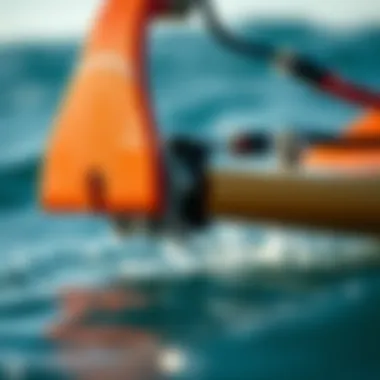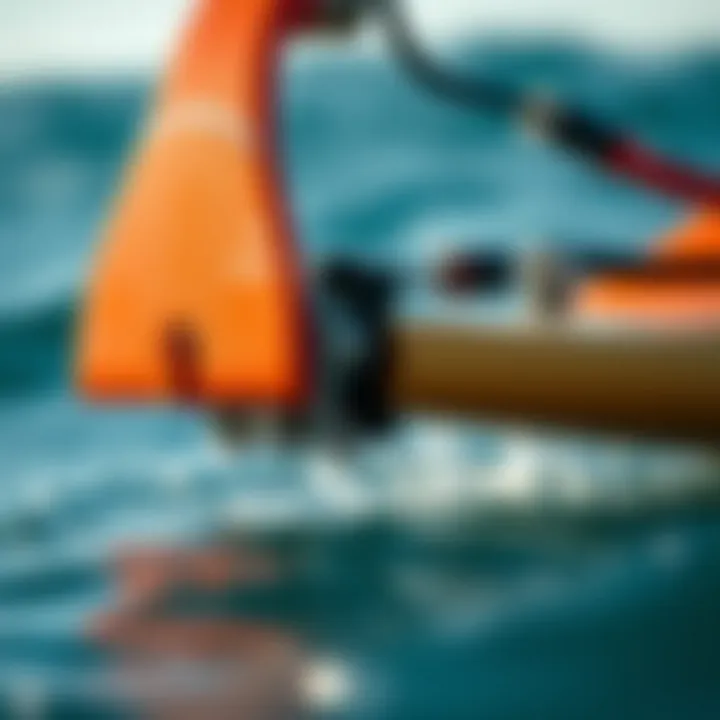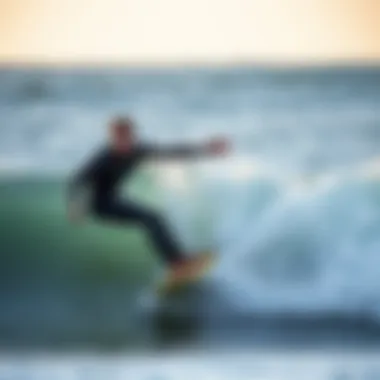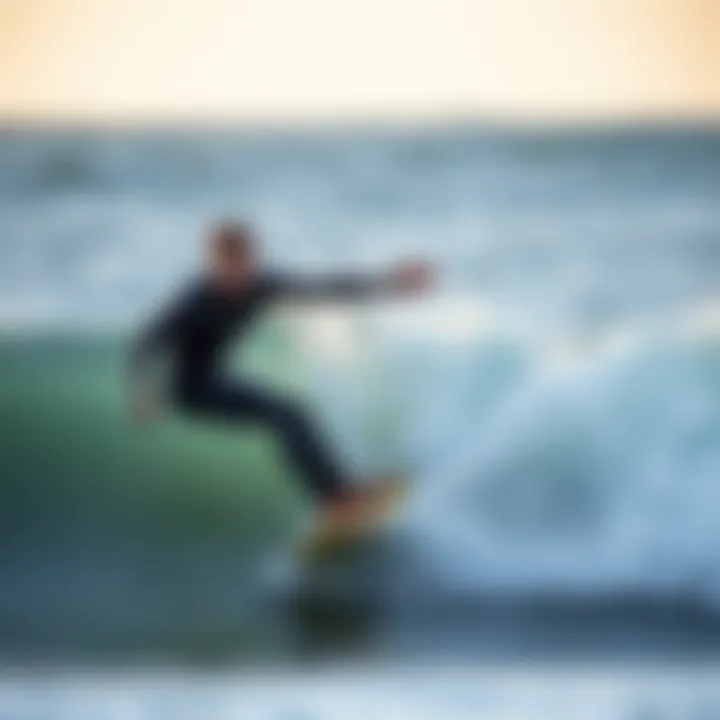Exploring Hydrofoil Surfboards: A Guide to Riding


Intro
Hydrofoil surfboards have carved out a remarkable niche in the world of water sports, representing a novel approach to riding waves without the help of an engine. Imagine gliding smoothly above the surface, feeling more like a bird than a surfer. Hydrofoils are the intersection of technology and nature, creating opportunities for both novices and seasoned surfers to explore new frontiers in their riding experience.
Unlike traditional surfboards that stay afloat through buoyancy alone, hydrofoils break through the surface tension of the water, allowing riders to elevate above it. This not only reduces drag significantly but also opens up possibilities for surfing in conditions that would otherwise be unrideable. So, whether it’s knee-high swells or choppy waters, these boards bring a fresh perspective to the surf scene.
As we delve into the specifics of gear and techniques needed for hydrofoil surfing, this guide aims to equip you with a solid understanding of the craft, its requirements, and how to optimize your performance while remaining environmentally conscious. Such thorough exploration is crucial for ensuring a fun and safe experience as you take to the waves with a hydrofoil.
Let’s dive right into the essentials of hydrofoil surfing gear and equipment.
Gear and Equipment
Getting the right gear is a critical first step to successful hydrofoil surfing. Unlike traditional surfing, the equipment used in hydrofoiling requires careful selection for both safety and performance.
Essential Hydrofoil Surfboard Gear for Beginners
If you are just starting out, here are some must-have items:
- Hydrofoil Board: Look for a beginner-friendly board with wider dimensions for stability. Brands like Flysurfer and Slingshot offer great options.
- Foil Setup: A good hydrofoil setup typically includes a mast, front wing, and rear wing. Larger wings (around 2000 cm² surface area) are advisable for novices, as they provide better lift.
- Safety Gear: Always wear a wetsuit plus a standard impact vest or a floatation vest. This not only keeps you safe but also helps visualize your in-water experience and temperature.
- Footstraps: Choose footstraps that are adjustable and comfortable. They play a crucial role in maintaining control over your board as you get used to riding on the foil.
- Leash: Make sure to have a reliable leash to keep your board attached to you, preventing it from drifting away in the water.
Advanced Equipment for Experienced Riders
For more seasoned hydrofoil surfers looking to up their skill, consider:
- Performance Boards: Thinner and lighter boards that improve maneuverability, such as those from Ozone or Naish.
- High-Aspect Foils: These foils have a longer wingspan and are more efficient at flying but may require better skill to handle. Brands like Axis Foils and Lift offer high-performance options.
- Carbon Fiber Upgrade: If you are serious about high speeds and effective navigation, a carbon fiber setup can provide unmatched performance and durability.
"Having the right gear can make the difference between a satisfactory ride and an exhilarating experience on the water."
Prelims to Hydrofoil Surfboards
When you hop on a surfboard, the feeling of gliding over the water can’t be beaten. But what if you could elevate that experience, quite literally? This is where hydrofoil surfboards come into play. These boards allow surfers to ride above the water’s surface, using a technology that’s not just a gimmick but a breakthrough in the surfing world.
This section sets the stage for what’s to come, shedding light on both the roots and the mechanics of hydrofoils. Hydrofoil surfboards might seem like an exclusive toy for seasoned riders, but they truly offer a range of benefits that appeal to both novices and experts alike. Understanding the core of what hydrofoils are can drastically enhance one’s approach to riding.
Defining Hydrofoil Technology
To put it simply, hydrofoil technology is all about the thin wing-like structures that are attached beneath the board. When a board is in motion, these foils create lift. Imagine the exhilaration of floating above the waves as if you are flying. The basic principle is not unlike aerodynamics in aircraft; with speed, the boat raises up, reducing drag while gaining speed.
Think of it this way: you know how it feels to ride a bike with flat tires? It’s tough and slow. But once you pump those tires full of air, everything changes. Hydrofoils work similarly to minimize resistance, making movements smooth and effortless. This technology doesn’t just elevate a board; it elevates the entire experience of riding. It's a game-changer on the water.
The Evolution of Surfboards
Now let’s take a quick stroll down memory lane. Surfboards of old were nothing like what you see today. They started with the heavy wooden planks of Hawaiian natives, evolving through foam constructions of the late 20th century to today’s high-tech designs. The introduction of the hydrofoil surfboard can be viewed as the next logical step in this evolution. It's the equivalent of going from a horse-drawn carriage to a sports car.
With changes in materials, shapes, and designs, each decade has brought new innovations. Today’s hydrofoil surfers have at their fingertips a combination of weightlessness and speed that was previously unimaginable. The evolution of these boards is not just about technology; it’s also about how surfing culture has expanded to embrace new and exciting ways to ride the waves. As this art form continues to develop, understanding hydrofoils plays a crucial role in keeping up with trends and future possibilities in the sport.
"Hydrofooils bring a new dimension to the idea of surfing, quite literally lifting the sport to greater heights."
In summary, this introduction lays a solid foundation for understanding hydrofoil surfboards by navigating through their technological definitions and the rich history leading to their development. If you’re keen to delve deeper into how these boards work, the mechanisms behind them, and what you need to ride them effectively, you're in for a treat in the following sections.
Understanding the Mechanics of Hydrofoils
In the realm of water sports, hydrofoil surfboards signify a transformative blend of physics and design. Understanding the mechanics of hydrofoils is crucial because it lays the foundation for mastery over these unique boards. Precisely how they function influences everything from performance to rider safety. The relationship between water dynamics and surfboard design becomes apparent when recognizing that hydrofoils are not merely for thrill-seekers; they represent advancements in how we engage with our aquatic environments.
How Hydrofoils Work
At the heart of hydrofoil technology lies the principle of lift. When speed increases, the hydrofoil, which is submerged under the water, generates lift. This effect arises when water flows over the foil’s wings, creating a pressure difference that allows the board to rise above the water's surface. No motor required, this lift enhances the efficiency of movement, allowing surfers to glide smoothly with minimal drag.
The rider's weight distribution, angle of attack, and speed all play a part in how the hydrofoil responds to water. Beginners might find it tricky initially, as subtle shifts can drastically affect performance. Yet, with practice, the rhythm between the rider and the foil creates a dance of balance and speed, improving their overall riding experience.
Key Components of a Hydrofoil Surfboard
A genuine understanding of hydrofoil surfboard mechanics involves a breakdown of its key components: the foil, board, and mast. Each part is engineered to work cohesively, contributing to the dynamic experience of hydrofoiling.


Foil
The foil itself is paramount in determining how effectively the board lifts. Typically constructed of lightweight materials like aluminum or carbon fiber, the foil's wings are designed to optimize lift while minimizing drag. A key characteristic of foils is their shape: a thicker front wing will usually generate more lift at lower speeds, suitable for newcomers. Yet, its potential downside lies in maneuverability. A larger wing might not turn as swiftly as a smaller one, which could frustrate more advanced riders seeking agility.
The unique feature of the foil that stands out is its adjustability. Many boards allow for wing swaps, granting versatility to suit different conditions or personal riding styles.
Board
Equally important is the board itself, which supports the rider while also housing the hydrofoil attachment. Boards can vary significantly in size and shape, reflecting different riding styles. An essential point here is that a longer board offers stability, making it more forgiving for beginners, while a shorter board can be more responsive for skilled surfer.
However, one must consider the trade-off; longer boards can feel cumbersome for advanced maneuvers, inhibiting the rider’s ability to perform tricks and sharp turns.
Mast
Finally, the mast connects the foil to the board and plays a crucial role in the hydrofoil's overall height above water. The mast’s length can vary, allowing riders to customize how high or low they ride based on water conditions and personal preference. A longer mast typically enables higher riding, enhancing speed and efficiency, but it may also introduce instability—something that less experienced riders might find challenging. A shorter mast, while more stable, limits height and can lead to less thrilling rides.
Understanding these components and their interactions can empower riders to make informed choices tailored to their personal style and the conditions they face.
In summary, each of these elements contributes intricately to the desired performance outcomes of hydrofoil surfboards. Grasping their mechanics doesn’t just enhance riding skills; it fosters a deeper appreciation for the science underlying one of water sports' newest frontiers.
Benefits of Using Motorless Hydrofoil Surfboards
Hydrofoil surfboards represent a remarkable leap in surfing technology. While many might be drawn to the flashy appearance of these boards, the true benefits extend deeper into performance and environmental considerations. Understanding these advantages can inspire both novices and seasoned riders alike to embrace motorless hydrofoiling.
Enhanced Performance and Speed
One of the most significant advantages of motorless hydrofoil surfboards comes from their remarkable ability to glide smoothly over the water's surface. Here’s how:
- Reduced Drag: Traditional surfboards create increased resistance when cutting through water. However, hydrofoils lift above the waves, minimizing water contact. This reduction in drag leads to quicker acceleration and sustained speed, especially in weaker surf.
- Improved Maneuverability: The unique design of hydrofoils enables surfers to execute sharp turns and perform tricks with greater ease than standard surfboards. Riders can lean into turns more effectively, providing a thrilling experience that feels almost like flying above the water.
- Consistency in Riding Conditions: These boards excel in varying conditions. Whether tackling small waves or larger swells, hydrofoil boards allow surfers to harness power from the ocean effectively. Consequently, riders can maximize their session time even when conditions aren't perfect.
- Physical Engagement: Riding a hydrofoil demands a lot from the rider’s body. This unique stance calls for balance and core strength, improving overall fitness. It’s a full-body workout that enhances not only surfing skills but also athletic ability in other sports.
"Hydrofoiling feels akin to soaring just above the water's surface; it's a sensation that can only be hinted at until experienced firsthand."
Environmental Considerations
Shifting towards motorless hydrofoil surfboards isn’t just about rider performance; it’s also about making an environmentally conscious choice:
- Eco-Friendly: Motorized water sports often contribute to pollution, both air and noise. Hydrofoil surfing steers clear of engines, thereby eliminating harmful emissions. This shift helps preserve our waterways for both aquatic life and future generations.
- Less Impact on Marine Life: The quieter operation of hydrofoil boards reduces disturbances to marine ecosystems compared to conventional motorized surfing. Sensitive habitats are safeguarded, promoting healthier environments for marine biodiversity.
- Sustainability in Product Manufacturing: An emerging trend in hydrofoil board production involves using eco-friendly materials. Manufacturers are more inclined to consider sustainable options, ensuring that the production of these boards places less strain on natural resources.
- Encouraging Conservation: As more riders take up hydrofoiling, they might also become advocates for ocean preservation. Those who experience the beauty of the ocean from above might feel compelled to protect it, fostering a community dedicated to sustainability in water sports.
In summary, motorless hydrofoil surfboards offer numerous benefits that stretch far beyond the thrill of riding. With advancements in performance and a commitment to environmental responsibility, these boards push surfers to new heights—figuratively and literally.
Types of Hydrofoil Surfboards
When it comes to selecting the right hydrofoil surfboard, understanding the various types available is key, as each type caters to different riding styles and conditions. This section will explore three predominant categories: All-Around Hydrofoil Boards, Performance Hydrofoils, and Freestyle Hydrofoil Surfboards. By examining these distinct designs, riders can better align their choices with their skills and needs, ensuring a rewarding experience on the water.
All-Around Hydrofoil Boards
All-Around Hydrofoil Boards serve as the bread and butter of hydrofoiling, designed for versatility and adaptability. These boards are typically wider, offering increased stability, which makes them ideal for beginners or those exploring a variety of conditions. The broad outline helps with balance, as riders can find their footing while they get accustomed to the nuances of hydrofoiling.
One of the main advantages of All-Around Hydrofoil Boards is their adaptability to different water conditions, whether it’s small swells or choppy seas. They're constructed to perform well in diverse scenarios, allowing surfers to enjoy a mix of riding styles. As a result, these boards can appeal to recreational surfers looking to dabble in various hydrofoil activities, from leisurely cruises to some spirited carving.
Benefits include:
- Stability for beginners.
- Versatile design for various water conditions.
- Suitable for both novice and experienced riders.
Performance Hydrofoils
On the other end of the spectrum, Performance Hydrofoils are tailored for those serious about maximizing speed and agility. These boards are generally narrower and lighter, crafted to respond swiftly to a rider’s commands. When you're zipping across the waves, every split-second counts, and performance boards excel precisely because of their design.
With a sharper rail and reduced drag, Performance Hydrofoils enable sharper turns and quicker acceleration, allowing more experienced riders to execute advanced maneuvers with ease. However, aspiring riders should be aware that although they can provide exhilarating rides, they require a higher skill level to fully appreciate their capabilities.
Key features include:
- Optimized for speed and agility.
- Sleeker design enhances maneuverability.
- Best suited for experienced hydrofoilers looking for a thrill.
Freestyle Hydrofoil Surfboards


Freestyle Hydrofoil Surfboards bring creativity and playfulness to the forefront. These boards are designed with specific tricks in mind, allowing riders to take their craft to new heights—literally. The board’s design often incorporates a shorter length and a tailored tail, giving riders the ability to execute jumps and spins with precision.
For those who thrive on the adrenaline of tricks, Freestyle Hydrofoils are invaluable. They encourage experimentation and bold moves, catering to riders who thrive on pushing boundaries. Freestyle riding often takes place in flatter waters or specific locations known for their conditions, making this type of board an exciting option for those who seek to innovate their style.
Considerations include:
- Specialty design for tricks and stunts.
- Best for riders looking to develop their freestyling skills.
- Often requires more practice to master.
The choice of hydrofoil surfboard type ultimately depends not only on the rider's current skill level but also on their ambitions within the sport. Whether it's the steady support of an All-Around board, the high-octane element of Performance Hydrofoils, or the daring flair of Freestyle boards, understanding these distinctions can enhance the experience on the water.
Riding Techniques and Tips for Hydrofoiling
When it comes to hydrofoiling, mastering the art involves more than just getting on a board and gliding over the waves. Riding techniques and tips are crucial for any enthusiast whether you are looking to ride with style or simply feel the thrill of being lifted above the water. These techniques provide a framework not just for safety, but also for enhancing the overall experience of hydrofoiling. Understanding how to control your board can lead to smoother rides and, ultimately, more fun.
Getting Started with Hydrofoiling
As with any sport, the initial stages can be daunting, but getting started in hydrofoiling is about building a solid foundation. Choose a calm day for your first venture. Familiarize yourself with the equipment - a well-balanced hydrofoil surfboard is essential. Begin in shallow waters where you can easily stand up, and practice strapping on the foot pads and harness. Don’t rush into deep waters until you feel comfortable.
- Warm-Up: Stretching is always a good idea before you start. You’ll be using muscles that might not be accustomed to this level of activity.
- Eye on the Horizon: Keeping your gaze fixed ahead, rather than down at your board, helps maintain balance.
- Practice Standing: Start by getting comfortable on the board without the foil in the water. Stride in crosses; it eases the transition into full riding when you lift off.
- Take it Easy: Begin with gentle paddling—don’t try to catch the biggest wave just yet.
Balancing and Controlling the Board
Once the ball gets rolling, balancing becomes second nature. Maintaining control of the board is a dance between your body and the waves. Here’s what to focus on:
- Foot Placement: Keep your feet parallel and centered, adjusting for comfort as needed. It's key to find your sweet spot.
- Weight Distribution: Leaning slightly forward can help lift the nose of the board but avoid putting too much weight on the front. This can cause the foil to breach the surface, disrupting your flow.
- Knees Bent: This lowers your center of gravity, helping with stability. Think of your knees as the springs of a pogo stick—absorb the bumps and flow over the water.
- Core Engagement: Engage your core muscles; they are essential for maintaining balance while you glide.
Advanced Maneuvers in Hydrofoiling
When you feel ready to level up, it’s time to explore advanced maneuvers. These tricks not only enhance your skill but can also result in a more exhilarating ride.
- Turns: Start with carving turns to shift your weight fluidly from edge to edge of the board. This often involves leaning into the turn and using your legs to guide the momentum.
- Jumping and Tricks: Once you’ve nailed the basics, try small jumps. Begin with a hover before pushing off the water for a few seconds. As you gain confidence, you might experiment with 180-degree turns or flips.
- Riding Waves: To catch waves properly, position yourself where you expect the swell to rise. Timing is everything; you want to start paddling in as the wave is building.
"Mastery comes not from blowing smoke, but from getting lost in the nitty-gritty details."
As you progress, keep practicing and refining your techniques. The beauty of hydrofoiling lies in its adaptability; each rider finds their rhythm, and your mastery will elevate the simple joy of riding above the water. Remember, taking your time is key; gradual improvement leads to satisfaction and safer riding.
Safety Considerations for Hydrofoil Riders
Safety is paramount when engaging in hydrofoil surfing. The freedom and thrill of riding a hydrofoil come with a host of potential risks. Therefore, understanding and managing these risks is essential for both enjoyment and preservation of health. Hydrofoiling can be exhilarating, but one must respect the water and acknowledge that safety gear and precautionary measures can prevent serious accidents. In this section, we'll dive into the essential safety gear needed and the inherent risks associated with this sport.
Essential Safety Gear
To enjoy hydrofoil surfing with peace of mind, having the right safety gear is crucial. Below is a list of essential gear that every rider should consider:
- Helmet: A good-quality helmet protects the head from falls or collisions. Look for helmets designed for water sports for a snug and secure fit.
- Impact Vest: This versatile piece of equipment provides buoyancy and protection to the torso. It can soften the blow if a rider falls or hits the water hard.
- Wetsuit: Besides keeping you warm, a wetsuit helps minimize abrasions and cuts from sharp edges of the hydrofoil or rough water conditions.
- Leash: A reliable leash attaches the board to the rider. In case of a fall, the board won't drift away, reducing risks to others in the water and making retrieval easier.
- Foot Straps: These allow for better control and stability. They can significantly reduce the chance of losing the board in choppy conditions.
Equipping yourself with proper saftey gear enhances confidence while riding the hydrofoil. The water can be unpredictable, and having the right equipment always pays off.
Understanding Risks and Precautions
Hydrofoiling can be thrilling, yet it isn't without its dangers. Recognizing potential hazards and employing strategies to mitigate them is critical. Here are some risks to be aware of:
- Falling Off the Board: Falls are inevitable, especially for beginners. They can result in injuries such as cuts or bruising, or worse, conccussions. Stay aware of your surroundings and be prepared for a sudden dismount.
- Collisions with Other Surfers or Objects: Hydrofoil surfboards can gain speed quickly. If you’re not paying attention, you may collide with fellow surfers or objects in the waters, leading to serious injuries.
- Weather and Water Conditions: Wind, waves, and currents can change rapidly. Always assess conditions before heading out. It's sensible to opt for calmer weather when you’re still learning.
To minimize these risks:
- Take time to learn about the specific water conditions and local hazards before venturing out.
- Notify someone about your surfing plans. If you’re alone and something goes wrong, having someone aware of your location can be lifesaving.
- Start in less crowded waters to familiarize yourself with the board and build confidence.
As a reminder, respect the ocean. It can be a great friend but also a fierce enemy. Adopting sound safety practices not only protects you but also ensures that everyone shares the waters harmoniously.
"Safety is not a gadget but a state of mind."
In the end, the goal is to have fun while keeping yourself out of harm's way. Being prepared helps you focus on mastering the skills necessary to enjoy hydrofoil surfboarding to the fullest.


Maintaining Your Hydrofoil Surfboard
Maintaining your hydrofoil surfboard is as vital as the riding itself. Proper care not only extends the lifespan of your board but also enhances its performance on the water. A well-maintained hydrofoil ensures that your riding experience is smooth and enjoyable. When you spend hard-earned cash on such equipment, it’s essential to treat it with the respect it deserves.
Cleaning and Storing Your Equipment
Cleaning your hydrofoil surfboard after each use is a key part of good maintenance. Saltwater, sand, and even freshwater can lead to corrosion or residue build-up if not addressed. Here’s a simple routine to keep your board and foil in prime condition:
- Rinse with Fresh Water: Directly after surfing, make sure to rinse your board with fresh water to remove any remnants of salt or sand. This minimizes the chances of corrosion on the foil and damage to the board’s finish.
- Use a Soft Cloth: Wipe down the board and foil with a soft cloth to prevent scratches; this can keep the appearance like-new for longer.
- Check the Components: While cleaning, inspect the mast and foil connection points for any signs of wear or loosing screws.
When it comes to storing your hydrofoil surfboard:
- Find a Cool, Dry Place: Avoid direct sunlight or damp locations. A garage or a dedicated rack prevents warping or degradation.
- Use a Board Bag: Investing in a protective bag can shield your board from scratches and keep it safe during transport.
- Store Vertically: If possible, store the board upright to prevent undue pressure on the fins and other components.
Inspecting for Wear and Damage
Regular inspections for wear and damage are essential parts of maintaining your hydrofoil surfboard. This could save you from unexpected mishaps while riding:
- Check the Foil: Inspect the foil for any dents or cracks. Minor damages can often be repaired, but anything major may require a replacement.
- Examine the Board: Look for any chips or cracks on the board itself. These may not look like much at first, but water ingress can lead to costly repairs.
- Mast Stability: Make sure that the mast is securely attached and free from rust or corrosion.
- Connection Points: Checking connection points where the mast meets the board is crucial for stability during rides.
By adhering to these maintenance practices, you ensure that your hydrofoil surfboard remains in the best shape possible, ready for whichever waters you choose to conquer next.
"A well-kept board is a happy board — and a happy board means more enjoyable riding sessions."
Further links for hydrofoil maintenance:
Adopting a keen eye for detail in maintenance doesn't just bolster your gear's performance; it can also sharply increase your safety on the water.
The Future of Hydrofoil Surfboarding
As the world of watersports continues to evolve, hydrofoil surfboards stand at the forefront of innovation. The future of hydrofoil surfboarding is painted with possibilities, driven by technological advances and a growing community of enthusiasts. Understanding what's on the horizon isn't just about gadgets and gizmos; it's also about how these boards could shape surfing culture and our environmental footprint.
Technological Innovations
Advancements in materials and design are ushering in a new era for hydrofoil surfboards. Manufacturers are employing cutting-edge materials, such as carbon fibers, which offer a perfect blend of strength and lightweight properties. This results in boards that glide effortlessly over waves, making the riding experience smoother than ever.
Another notable innovation is the integration of smart technology into the boards themselves. This includes sensors that track speed, altitude, and weight distribution, providing riders with valuable feedback to enhance their technique. Innovations like these are not just gimmicks; they could be essential in helping novices grasp the nuances of hydrofoiling without the steep learning curve typically associated with new sports.
In terms of design, the shapes of hydrofoils are constantly being tweaked to optimize performance across various conditions. Curved wings are being tested for their ability to maintain lift even in choppy waters. The trend suggests that as technology advances, more riders will find a board that aligns closely with their personal riding style as well as the environmental conditions they face.
"Innovation is the key to staying relevant, and in the world of hydrofoils, that means constantly evolving."
Expanding Community and Culture
The hydrofoil surfboarding community is burgeoning, and its growth is a tapestry woven from various threads. From local surf shops to international competitions, interest in hydrofoils has ignited conversations that include everyone from kiteboarders to traditional surfers. This cross-pollination of interest can only benefit the sport, as seasoned riders share knowledge and insights with newcomers, leading to a more enriched experience for everyone involved.
Social media platforms and forums, such as those on Reddit or specialized Facebook groups, are fostering a culture of sharing tips, tricks, and personal experiences. Riders are posting videos showcasing their most exhilarating rides, inviting others to engage with the sport. This informal sharing of techniques fosters a sense of camaraderie and collective improvement.
Moreover, as more people take to hydrofoil surfing, there's a growing emphasis on environmental responsibility. Riders are becoming vocal advocates for ocean conservation, making informed choices about the materials they purchase and the environments in which they ride. This shift not only promotes a more sustainable approach to surfing but also binds the community together through shared values.
The End
As we've journeyed through the intricate world of hydrofoil surfboards, it becomes apparent that this innovative surfing technology offers a unique blend of excitement and challenge. The capabilities of motorless riding not only bring a fresh perspective to the sport but also encourage a deeper connection with nature. From the mechanical workings of hydrofoils to the tips for maintaining and riding them, every aspect discussed contributes to a fuller understanding of what makes hydrofoil surfing so appealing.
Summarizing Key Points
Let's take a moment to condense our exploration:
- Hydrofoil technology transforms traditional surfing by elevating the rider above the water, resulting in a smoother ride even in choppy conditions.
- The benefits of going motorless extend beyond performance; environmental considerations stand out as hydrofoil boards reduce reliance on fossil fuels, supporting eco-friendly practices.
- Various types of hydrofoil surfboards are available, catering to different riding styles and preferences. Whether you’re into freestyle or looking for an all-around board, there's a fit for every surfer.
- Essential riding techniques emphasize balance, control, and the joy of mastering advanced maneuvers that define the hydrofoiling experience.
- Maintenance tips ensure longevity and safety, allowing riders to fully enjoy their boards without pesky interruptions.
In summary, hydrofoiling encapsulates a forward-thinking approach to surfing that combines thrill and mindfulness. Conclusively, understanding the mechanics, benefits, and techniques associated with hydrofoil surfboards is crucial for both new enthusiasts and seasoned surfers alike.
Encouragement for New Riders
To all the newcomers considering entering this exhilarating sport, take heart! Hydrofoiling may appear intimidating at first glance, but it is a journey filled with rewards. Start slow, practice your balance, and don’t shy away from those tumbling falls—they often lead to the most valuable learning experiences. Remember:
- Every expert was once a beginner. The key is persistence.
- Engage with local hydrofoiling communities—ask questions, share experiences, and learn from others. You’ll find camaraderie among fellow riders.
- Stay informed and invest time in understanding your gear. The more familiar you are with your equipment, the more confident you will feel on the water.
In a nutshell, harness the wind, dance with the waves, and embrace the wind beneath your wings with hydrofoil surfboards. You might just find a new passion that lifts you above the water—both literally and figuratively.















